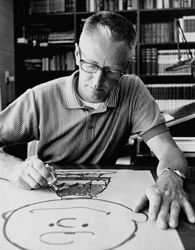For more than 50 years, Charles Schulz’s comic strip Peanuts has been an essential part of the newspaper’s daily comics page for millions of children and adults alike. Although the strip has brought joy to many, it is thought that perennial sad-sack Charlie Brown, who never gets the girl nor feels accepted by others, served as a window into Schulz’s own life.
Charles Schultz’s Early Days
Charles Monroe Schulz was born on November 26, 1922, in Minneapolis, Minnesota. “Sparky” Schulz, an only child, remembered his childhood as one of the happiest times in his life.
Schulz was a smart child and skipped a few grades. Yet, as Time magazine points out, this meant that when he reached junior high school he was the “smallest, youngest boy in the class.” Of his high school years he would later say, “it took me a long time to become a human being…I never regarded myself as being much.” This feeling was reinforced when his drawings were rejected by his high school senior yearbook, which could be the inspiration for a Peanuts strip in which Snoopy receives a rejection letter reading, “You are a terrible writer. Why do you bother us? …Leave us alone. Drop dead.”
At age 20, Schulz was drafted into World War II; a few days before he shipped out, his mother died of cancer. Her death and his experiences in the army left Schulz feeling more alone than he had in high school. After he was discharged, he moved back home with his father and began his career as a cartoonist.
Sources in this Story
- Time magazine: Passages: The Life and Times of Charles Schulz
- PBS American Masters: Good Ol’ Charles Schulz: Career Timeline
- Schulz Museum: Schulz & Peanuts Time Line
- Time magazine: The 100 Best TV Shows of All-Time
- Peanuts Wiki: January 2000 comic strips
- The Wall Street Journal: The Grief That Made Peanuts’ Good
- USA Today: Schulz’s family says cartoonist unfairly drawn in new bio
- NPR Weekend Edition Saturday: Charlie Brown: Authenticity and Honesty
- San Jose Mercury News: Peanuts creator Charles Schulz’s widow flees Santa Rosa fire, home destroyed
Schultz’s Notable Accomplishments
Originally called “Lil’ Folks,” the strip was renamed “Peanuts” by United Feature Syndicate, the first publisher to syndicate the comic. According to the Schulz Museum, it was a name Schulz never really liked. Eventually, the “Peanuts” gang—Charlie Brown, Snoopy, Linus, Lucy, Peppermint Patty and the rest—would appear in more than 2,600 newspapers worldwide.
The strip was eventually adapted into animated TV specials, and many families do not consider their holidays complete without watching “It’s the Great Pumpkin, Charlie Brown” or “A Charlie Brown Christmas.” Peanuts also inspired a 1967 musical, “You’re a Good Man, Charlie Brown,” which has been produced several times over the years.
The Man and his Work
- “Schulz and Peanuts: A Biography” by David Michaelis
- “Peanuts Holiday Collection (It’s the Great Pumpkin, Charlie Brown/A Charlie Brown Thanksgiving/A Charlie Brown Christmas)” (DVD)
- “The Complete Peanuts 1950–1954 Box Set” by Charles M. Schulz
- The Original Cast Album of “You’re a Good Man, Charlie Brown” (CD)
The Rest of the Story
On January 3, 2000, Charles M. Schulz bade his readers farewell with a last comic strip. In it, he said he was sorry that he was no longer able to “maintain the schedule demanded by a daily comic strip.” Schulz died a little more than a month later on February 12, 2000. On May 27, 2000, about 100 syndicated cartoonists paid tribute to Schulz by publishing “Peanuts”-themed comic strips. Many newspapers continue to rerun Schulz’s old strips.
Several biographers believe that Charlie Brown and other “Peanuts” characters were based on Schulz and the people in his life. Bill Watterson, creator of the comic strip “Calvin and Hobbes,” reviews one such biography by David Michaelis, “Schulz and Peanuts: A Biography.”
Watterson writes that what struck him most about the book is how Schulz used the comic strip to express the unhappiness in his own life. “The strips used as illustrations in ‘Schulz and Peanuts’…vividly demonstrate how Schulz used his cartoons to work through private concerns. We discover…[that] the crabby and bossy Lucy stands in for [Schulz’s first wife] Joyce, and the obsessive and talented Schroeder is a surrogate for Schulz.”
Schulz’s family has disputed this depiction of Schulz. According to USA Today, Schulz’s oldest son, Monte Schulz, “says the book accentuates the negative, gets some facts wrong and shortchanges his father’s ‘joys, his passions,’” while his daughter Amy Johnson says she felt “deceived” by the author.
In an interview with National Public Radio’s Scott Simon, three eight-year-old boys exclaim Charlie Brown is “cool” because “he’s his own person.” Simon concludes Charlie Brown may be something “more extraordinary” among children and even adults. “Despite all temptation and frustration, his bruised heart and backside, Charlie Brown is nice. And do we tell ourselves often enough, and do we tell our children, how important that really is?”
Charles Schulz’s Santa Rosa home was destroyed in October 2017 when a fast-moving wildfire consumed it. His widow was able to safely evacuate. Some items related to the Peanuts were destroyed in the fire, but the Peanuts museum, where the bulk of memorabilia is housed, was not damaged in the wildfires. More than 40 people died and hundreds of structures were destroyed in the Northern California wildfires.
This article was originally written by Kate Davey; it was updated November 27, 2017.











